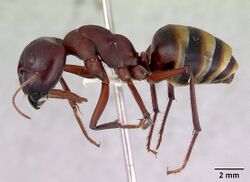Biology:Camponotus aurocinctus
| Camponotus aurocinctus | |
|---|---|

| |
| Camponotus aurocinctus worker | |
| Scientific classification | |
| Domain: | Eukaryota |
| Kingdom: | Animalia |
| Phylum: | Arthropoda |
| Class: | Insecta |
| Order: | Hymenoptera |
| Family: | Formicidae |
| Subfamily: | Formicinae |
| Genus: | Camponotus |
| Species: | C. aurocinctus
|
| Binomial name | |
| Camponotus aurocinctus (Smith, F., 1858)
| |
| Synonyms | |
| |
Camponotus aurocinctus is a species of ant in the genus Camponotus. The ant was described by Smith in 1858.
Taxonomy
Camponotus aurocinctus was first identified by Frederick Smith in 1858, in his Catalogue of hymenopterous insects in the collection of the British Museum part VI.[1] The species currently has one synonym published – Camponotus midas, described by Walter Wilson Froggatt in 1896.[2]
Distribution
The species is endemic to Australia , and prefers to nest in ground soil, but colonies have strong preferences for nesting in sandy like soils and is usually more encountered foraging during late day times.[3] Workers observed while foraging are found on low vegetation or on the ground, and have been found Stockyard Plain and Danggali Conservation Park in South Australia.[3]
References
- ↑ Frederick Smith (1858). Catalogue of hymenopterous insects in the collection of the British Museum part VI. London: British Museum. p. 39. http://www.antwiki.org/wiki/images/5/59/Smith_1858a.pdf. Retrieved 21 August 2014.
- ↑ Froggatt, W. W. 1896. Honey ants. Pp. 385–392 in: Spencer, B. (ed.) 1896. Report on the work of the Horn Scientific Expedition to Central Australia. Part II. Zoology. London: Dulau & Co., iv + 431 pp. (page 390, pl. 27, figs. 6-9 soldier, worker, queen described)
- ↑ 3.0 3.1 Shattuck, S.O; McArthur, A.J. (2002). "A taxonomic revision of the Camponotus wiederkehri and perjurus species-groups (Hymenoptera: Formicidae)". Transactions of the Royal Society of South Australia 126: 63–90. ISSN 0372-1426.
External links
Wikidata ☰ Q9686644 entry
 |


